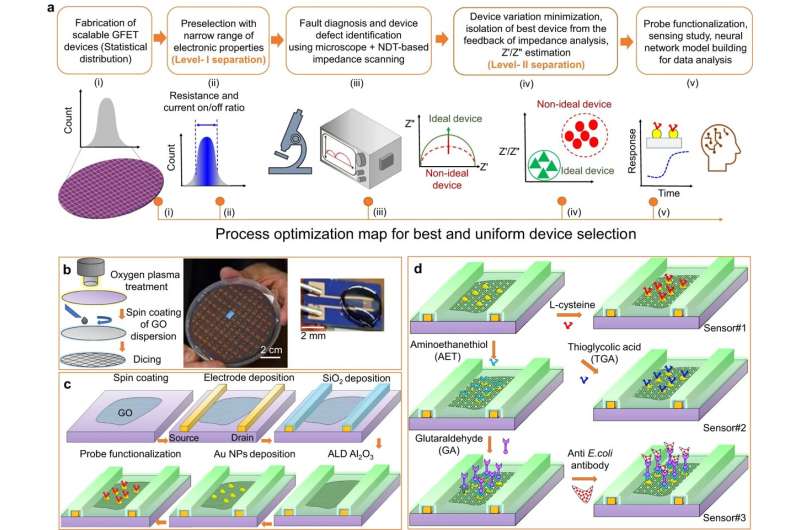This article has been reviewed according to Science X's editorial process and policies. Editors have highlighted the following attributes while ensuring the content's credibility:
fact-checked
peer-reviewed publication
trusted source
proofread
Pivotal discovery in sensor technology eliminates faulty electronic sensors when measuring toxins in water

There is a global water crisis, and it is not only about the dwindling supply of clean water. Contaminated drinking water exposes hundreds of millions of people worldwide to toxins, such as bacteria, heavy metals, pesticides and coronaviruses. This contamination imperils public health and can cause serious illnesses.
A team of researchers from the U.S. Department of Energy's Argonne National Laboratory, along with the Pritzker School of Molecular Engineering at the University of Chicago and the University of Wisconsin—Milwaukee, has devised a pathway for the mass manufacture of sensors able to simultaneously detect lead, mercury and E. coli. in flowing tap water. The team's innovation promises to help safeguard public health by providing early warning for contamination.
"Traditionally, sensors designed to measure contaminants in water have suffered from reliability issues and the inability to detect faulty devices," said Argonne scientist Haihui Pu, who holds a joint appointment with UChicago's Pritzker Molecular Engineering. "Improved sensors could avert health crises."
At the core of these sensors lies a one-nanometer-thick layer of carbon and oxygen atoms, a form of graphene, which is coated on a silicon substrate. This graphene material serves a similar purpose to the semiconductors found in computer chips. Gold electrodes are then imprinted onto the graphene surface, followed by a nanometer-thick insulating layer of aluminum oxide. Each sensor is tailored to detect one of the three toxins: lead, mercury or E. coli.
One of the major challenges in mass manufacturing these sensors has been assessing their quality. Tiny areas of undesired porosity can form in the ultra-thin insulating layer. This porosity allows electrons from the bottom graphene layer to escape into the top insulating layer. This leakage compromises its effectiveness as an insulator and results in unreliable sensor responses.
The team's recent publication in Nature Communications describes a screening method to identify defective devices before mass production. The method involves measuring the electrical response of the insulating layer while the sensor is submerged in water. Key is that the screening does not damage the sensor. By employing this technique, the team identified structural defects in the insulating layers. They were then able to establish criteria to easily detect faulty devices.
To demonstrate the efficacy of their approach, the team evaluated a three-sensor array able to simultaneously detect lead, mercury and E. coli in flowing tap water. Using machine learning algorithms to analyze the results, they were able to quantify toxin levels down to the parts per billion, even in the presence of interfering elements.
"The beauty of the sensors is that you can apply them in any form of water, not just tap water," said Junhong Chen, Argonne's lead water strategist and Crown Family Professor at Pritzker Molecular Engineering. "What's more, you can combine three, thirty or three hundred sensors, with each tailored to detect different constituents."
These include not only heavy metals and bacteria, but pharmaceuticals, pesticides, coronaviruses and a common contaminant in water, per- and polyfluoroalkyl substances. They might also include critical resources, such as cobalt for batteries and nitrogen and phosphorus as nutrients for plants and animals.
Once problematic or valuable elements are identified and removed, the sensors can be used to assess the cleanliness of treated water. The results can guide the safe reuse of the water, including potable use, agriculture and irrigation, groundwater replenishment and industrial processes.
Chen expressed hope for commercializing this technology through a startup company he founded. "But water contamination poses a global health problem demanding collective efforts," he said.
The team's screening method offers a versatile tool for monitoring water quality and optimizing its safe reuse. As scientists tackle this critical issue, their efforts serve as a beacon of hope for a healthier, more sustainable future.
More information: Arnab Maity et al, Scalable graphene sensor array for real-time toxins monitoring in flowing water, Nature Communications (2023). DOI: 10.1038/s41467-023-39701-0
Journal information: Nature Communications
Provided by Argonne National Laboratory




















